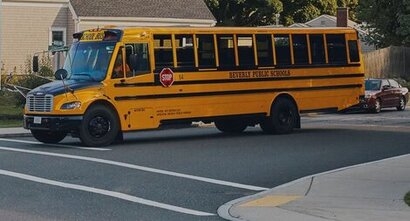
The buses returned more than 80 hours of energy back to the electricity grid for more than 80 hours over the course of the summer, helping to reinforce the grid during some of the hottest days when electricity was most in demand.
Working with technology partners Thomas Built Buses, Proterra, Rhombus and Synop, Highland Electric Fleets operated the Thomas Built Buses electric buses over 32 grid events during the summer, demonstrating the viability of electric buses as V2G resources and providing a template to scale the service at additional deployments in Vermont, Maryland, Colorado, California, Virginia and beyond.
“Electric school buses are ideal assets for V2G applications” said Sean Leach, director of technology and platform management at Highland. “Nearly 500,000 school buses in North America spend most of their time parked. Fossil fuel-powered buses provide no value when idle. Electric buses, on the other hand, can be used effectively as mobile batteries when not transporting students to provide additional power that supports grid stability and resiliency. We're excited to work with top-tier partners to scale V2G programs and benefits to other communities.”
Utilities can reduce emissions by using electric school buses as distributed energy resources (DER) when energy demand spikes, rather than firing up conventional fossil fuel resources for short periods of time. The Beverly deployment is providing essential data that will enable National Grid and other utilities to scale similar V2G programs in the future for more sustainable energy systems.
This is the second summer that electric school buses in Beverly have served as V2G assets: in 2021, Highland coordinated the same partners to use a Proterra Powered, Thomas Built Buses Saf-T-Liner C2 Jouley to send around three MWh of energy back to the grid over nearly 60 hours spanning 30 events. The cumulative 10 MWh the buses have sent to the grid makes a meaningful contribution to the energy mix and alleviates strain on the electric system. According to the state of Massachusetts, the average residential customer uses approximately 500 kWh per month – about 17 kWh per day. The 10 MWh (10,000 kWh) from the buses is enough to power nearly 600 homes for a day.
Chris Bailey, president of Proterra Powered & Energy, added that communities across the country are transitioning to a 100 percent clean energy and clean transportation future and that electric school buses can play an important role in driving this switch – bringing a cleaner, quieter mode of transportation for students while also supporting a more local and resilient energy system by delivering stored energy back to the grid when it's needed most.
The Saf-T-Liner C2 Jouley couples 226 kilowatt hours (kWh) of total energy capacity from Proterra's industry-leading battery technology with a Proterra electric drivetrain to offer up to 138 miles of drive range to meet the needs of school bus fleets.
Rhombus Energy Solutions' 60 kW high-powered DC fast charger, certified to UL 1741-SA standards, meet rigorous requirements to ensure safe and reliable operation, and can provide bidirectional charging capabilities for up to five school buses per power control system.
Synop provides fleet managers an end-to-end solution that helps regulate energy on the grid and provides new financial opportunities for fleets. Between charging management, route planning, and energy monitoring and V2G orchestration, Synop automates EV operations at scale and accelerates commercial electrification.
“For cities looking to optimise their energy grid, V2G is a breakthrough technology, and its full capacity is only realized when it can be applied to EV fleets” said Gagan Dhillon, co-founder and CEO of Synop. “A cross-organization collaboration of this nature is crucial to unlocking that capacity and producing the tremendous environmental and economic benefits.”
For additional information:

